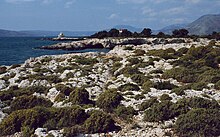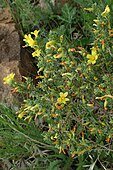| This is a Wikipedia
user page. This is not an encyclopedia article or the talk page for an encyclopedia article. If you find this page on any site other than Wikipedia, you are viewing a mirror site. Be aware that the page may be outdated and that the user in whose space this page is located may have no personal affiliation with any site other than Wikipedia. The original page is located at https://en.wikipedia.org/wiki/User:Fritzmann2002/sandbox. |
| Fritzmann2002/sandbox | |
|---|---|

| |
| Hypericum aegypticum, the most common species in the section | |
|
Scientific classification
| |
| Kingdom: | Plantae |
| Clade: | Tracheophytes |
| Clade: | Angiosperms |
| Clade: | Eudicots |
| Clade: | Rosids |
| Order: | Malpighiales |
| Family: | Hypericaceae |
| Genus: | Hypericum |
| Section: |
Hypericum sect. Adenotrias (Jaub. & Spach) R. Keller |
| Type species | |
|
Hypericum russeggeri (Fenzl) R. Keller
| |
| Species | |
| |
Adenotrias is a section of flowering plants in the family Hypericaceae. It is made up of Hypericum aciferum, H. aegypticum, and H. russeggeri (its type species). When it was first described, it was considered its own independent genus, but was later placed under Hypericum and demoted to a section. Its Latin name Adenotrias is made of the Greek prefix adeno- (referring to glands) and the Latin word trias (meaning three or a triad).
Etymology
The genus name Hypericum is possibly derived from the Greek words hyper (above) and eikon (picture), in reference to the tradition of hanging the plant over religious icons in the home. [1] The section name Adenotrias is made up of the Greek prefix adeno-, which refers to glands, [2] and the Latin word trias (borrowed from the Greek triás), which refers to a group of three or a triad. [3] The only species in the section with a common name is Hypericum aegypticum, called shrubby St. John's Wort or Egyptian St. John's Wort. [4]
Taxonomy
Throughout its history, the name Adenotrias has been applied to several different taxa by different authors. The name was first used by French botanist Édouard Spach in 1842 to establish a new genus, separate from the large taxon Hypericum. [5] [6] Spach formed this genus around three species: Adenotrias phrygia and Adenotrias kotschyi (both later determined to be synonyms of Hypericum russeggeri), [7] [8] and Adenotrias aegypticum (moved from Triadenia and today accepted as Hypericum aegypticum). [6]

Original description of the species by Eduard Fenzl in 1842 under the synonym Triadenia russeggeri
In Adolf Engler's textbook Die Natürlichen Pflanzenfamilien in 1893, Robert Keller moved a species previously known as Triadenia russeggeri or Elodes russeggeri into Hypericum, making the new combination Hypericum russeggeri. Keller also created a new taxon, called Hypericum section Adenotrias, to hold the species, establishing the modern conception of Adenotrias as a section within Hypericum. [10] Later, in 1893, Keller addressed the already existing genus Adenotrias as created by Spach, synonymizing A. phrygia and A. kotschyi with H. russeggeri and merging A. aegypticum into the section as Hypericum aegypticum. [6]
In 1965, Werner Greuter described a new species in the journal Candollea. He placed it in the genus Elodes, which had also been split from Hypericum in the 19th century, creating the name Elodes acifera. He noted its close relation to a species he called Elodes russeggeri (a synonym of Hypericum russeggeri), and thus created a new section within Elodes which he called Elodes section Adenotrias. [11] However, this situation was short-lived, as British taxonomist Norman Robson described the species again in 1967 in the journal Feddes Repertorium, moving it into the genus Hypericum under its currently accepted name Hypericum aciferum. [12] This synonymized Elodes sect. Adenotrias with Hypericum sect. Adenotrias, a placement Greuter corroborated in 1973. [13]
Norman Robson subsequently began work on a monograph of the genus Hypericum, which discussed sect. Adenotrias several times. In the first volume, published in 1977, Robson designated Hypericum russeggeri as the type species of the section. [14] In the sixth volume of the work, published in 1996, Robson incorporated Adenotrias into his framework of 36 sections within the genus. He affirmed that is was made up of H. aciferum, H. aegypticum, and H. russeggeri—three species of shrubs found among limestone rocks which vary greatly in appearance. [15] Several studies of the molecular phylogenetics of the section have confirmed this composition, as well as its species' close relationship to one another. [16] [17]
Description
Species in Adenotrias are
- Species of H. sect. Adenotrias
-
H. aciferum
-
H. aegypticum
-
H. russeggeri
Plants in the section have a chromosome number of 2n = 10, and are diploid.
Heterostyly
Chemistry
Distribution, habitat, and ecology

H. russeggeri is parasitized by Cyphodema rubrica, a capsid bug. [18] H. aciferum grows among many other flowering plants, [19] [Note 1] and in Pinus halepensis forest. [20] It has been seen spreading via myrmecochory; ants help to disperse its seeds by carrying them from one place to another. [21]
Conservation and cultivation
Hypericum aciferum was evaluated as an endangered species several times in the 1980s and 1990s, [22] [19] [23] and was listed as a "strictly protected flora species" by the European Environment Agency. [24] Since 2015, the species has been protected in a plant micro-reserve (PMR) of around 6.5 hectares located near Agia Roumeli on the island of Crete. [25] However, because of critically low numbers of surviving plants, there is still a high risk of extinction from threats like human activity, fire, and habitat erosion. [26] In spite of these threats, the IUCN re-evaluated the species in 2021, assessing it as vulnerable and as having a stable population. [27]
Hypericum aegypticum has a wide distribution, but was identified by the Maltese Red Data Book as having a threatened status on Malta; however, no legal action had been taken for the protection of the species as of 2021. [4]
Hypericum aciferum has extremely low suitability for use as a garden plant. [28] While Hypericum aegypticum is not widely cultivated, it is present in botanical gardens, including in a greenhouse at the University of Oxford Botanic Garden. [29]
Notes
- ^ These include Allium bourgeaui, Centaurea argentea, Dianthus fruticosus, Origanum dictamnus, Ornithogalum creticum, and Staehelina fruticosa.
References
- ^ Coombes 2012, p. 172.
- ^ Davis, Charles. "Definition of adeno-". RxList. Retrieved 17 July 2024.
- ^ Lewis, Charlton; Short, Charles (1879). "trias". A Latin Dictionary. Retrieved 17 July 2024.
- ^ a b Mifsud, Stephen (23 August 2002). "Hypericum aegypticum (Shrubby St. John's Wort)". Wild Plants of Malta & Gozo. Retrieved 30 December 2017.
- ^ "Adenotrias". Plants of the World Online. Royal Botanic Gardens, Kew. Retrieved 17 July 2024.
- ^ a b c Robson 1977, p. 306.
- ^ "Adenotrias kotschyi". Plants of the World Online. Royal Botanic Gardens, Kew. Retrieved 17 July 2024.
- ^ "Adenotrias phrygia". Plants of the World Online. Royal Botanic Gardens, Kew. Retrieved 17 July 2024.
- ^ Fenzl 1842, p. 7.
- ^ Engler et al. 1893, p. 209.
- ^ Greuter 1965, p. 216.
- ^ "Hypericum aciferum (Greuter) N.Robson". Plants of the World Online. Kew Science. Retrieved 2024-02-28.
- ^ Robson 1996, p. 153.
- ^ Robson 1977, p. 334.
- ^ Robson 1996, p. 148.
- ^ Meseguer, Aldasoro & Sanmartín 2013, p. 386.
- ^ Robson 2016, p. 191.
- ^ Ellis, W.N. (2022). "Hypericum russeggeri". Plant Parasites of Europe. Retrieved 11 April 2024.
- ^ a b Kypriotakis 1995, p. 316.
- ^ Gotsiou, P.; Kokkinaki, A.; Fournaraki, C.; et al. (30 March 2021). "Hypericum aciferum". IUCN Red List. Retrieved 3 March 2024.
- ^ Thanos, Kaltsis & Koutsovoulou 2013, p. 153.
- ^ " Hypericum aciferum". List of rare, threatened and endemic plants in Europe. 1983. pp. 113, 198
- ^ " Hypericum aciferum". IUCN Red List of Threatened Species. 1997. p. 297.
- ^ " Hypericum aciferum". Checklists for the CORINE Biotopes Programme. 1994. pp. 112, appendix 2.
- ^ Thanos et al. 2013, p. 28.
- ^ Thanos et al. 2013, p. 33.
- ^ Gotsiou, P.; Kokkinaki, A.; Fournaraki, C.; et al. (30 March 2021). "Hypericum aciferum". IUCN Red List. Retrieved 3 March 2024.
- ^ Krigas et al. 2021, p. 2556.
- ^ "Hypericum aegypticum". elianto.fisica.unimi.it. Retrieved 8 April 2022.
Bibliography
- Coombes, Allen J. (2012). The A to Z of plant names: a quick reference guide to 4000 garden plants. Portland, Oregon: Timber Press, Inc. ISBN 978-1-60469-196-2.
- Engler, Adolf; Krause, Kurt; Pilger, Robert; et al. (1893). Die Natürlichen Pflanzenfamilien (in German). Vol. 3. Leipzig: W. Engelmann.
- Greuter, Werner (1965). "Beitrage zur Flora der Sudagais 1-7" [Contributions to the Flora of the South Aegean]. Candollea (in German). 20 – via E-Periodica.
- Krigas, Nikos; Tsoktouridis, Georgios; Anestis, Ioannis; Khabbach, Abdelmajid (2021). "Exploring the Potential of Neglected Local Endemic Plants of Three Mediterranean Regions in the Ornamental Sector: Value Chain Feasibility and Readiness Timescale for Their Sustainable Exploitation". Sustainability. 13 (5): 2539. doi: 10.3390/su13052539.
- Kypriotakis, Zacharias (1995). Red Data Book of Greece (PDF). Greece: Hellenic Botanic Society.
- Meseguer, Andrea; Aldasoro, Juan; Sanmartín, Isabel (2013). "Bayesian inference of phylogeny, morphology and range evolution reveals a complex evolutionary history in St. John's wort (Hypericum)" (PDF). Molecular Phylogenetics and Evolution. 67 (2): 379–403. Bibcode: 2013MolPE..67..379M. doi: 10.1016/j.ympev.2013.02.007. hdl: 10261/167045. PMID 23435266 – via Elsevier.
- Robson, Norman K.B. (1977). "Studies in the genus Hypericum L. (Guttiferae) 1. Infrageneric Classification". Bulletin of the British Museum (Natural History). Botany. 5 (6): 291–355. Retrieved 5 June 2022 – via Biodiversity Heritage Library.
- Robson, Norman (1996). "Studies in the genus Hypericum L. (Guttiferae) 6. Sections 20. Myriandra to 28. Elodes". Bulletin of the Natural History Museum. Botany. 26 (2) – via Biodiversity Heritage Library.
- Robson, Norman (2016). "And then came molecular phylogenetics—Reactions to a monographic study of Hypericum (Hypericaceae)". Phytotaxa. 255 (3): 181. doi: 10.11646/phytotaxa.255.3.1 – via ResearchGate.
- Thanos, Costas; Fournaraki, Christini; Georghiou, Kyriacos; Dimopoulos, Panayotis (2013). "PMRs in western Crete". Plant Micro-Reserves: From Theory to Practice. Utopia Publishing. ISBN 978-618-80647-2-0.
- Thanos, Costas; Kaltsis, Apostolis; Koutsovoulou, Katerina (2013). "PMRs as Field Laboratories for Scientific Research". Plant Micro-Reserves: From Theory to Practice. Utopia Publishing. ISBN 978-618-80647-2-0.



